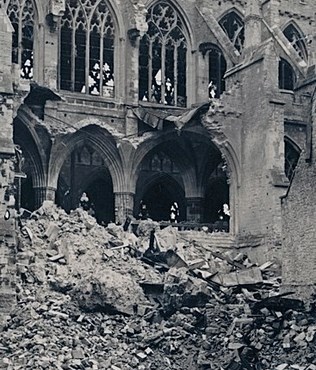The Conundrum
The major "Baedeker Raid" targets were chosen for their cultural not military significance.......the "Three Star" reference.
Is it surprising therefore, that the Abbeys, Minsters and Cathedrals in these cities were not destroyed or badly damaged?

A selection of websites on the subject report.........
Exeter............"if they were aiming for the Cathedral they failed spectacularly."
Bath..............."wasn't directly hit but windows were damaged by blast."
Norwich.........."the Cathedral escaped the bombs and fires that ravaged so many other buildings."
York..............."not directly targeted."
Canterbury....."barely touched by any of the raids."
Although many people were killed and injured and thousands of buildings both ancient and modern were destroyed, the cultural symbols of obvious "Three Star Rating" were largely untouched.
It would seem that there might have been a policy of not inflicting damage that would cause negative publicity.
However, Robert Bevan, in "The Destruction of Memory: Architecture at War" states.
"If anything, the opposite is true. This sequence of raids on historic cities was the start of an open season for the indiscriminate bombing of cultural and civilian centres. Monuments were fair game."
He goes on to state......"Their survival rate, given the difficulty of accurate targeting, can be put down to both luck and the relative non-combustibility of their massive stone structures."
Indeed it was reported that a German bomber circled low several times over Exeter Cathedral before dropping a bomb through the roof that caused significant damage but not total destruction.

Damaged caused by the bomb dropped on Exeter Cathedral (photo credit: unknown)
A secretly made recording and transcription of a conversation between two captured "Baedeker Blitz" crew members gives an interesting insight. He is relating a description of his own interrogation to a wireless operator captured during the first raid on Exeter.
"He (the Intelligence Officer) asked what my target was at York. Was it the Minster? I said I hadn't been present at the briefing but that the pilot had told me to look for the railway-station. As a matter of fact, I was present. I wonder whether we were supposed to bomb the Minster!......it's just next to the station."
Post war reading of Goebbels's diaries shows that he wrote, "Like the English, we must attack centres of culture. Such centres should be attacked two or three times in succession and levelled to the ground; then the English probably will no longer find pleasure in trying to frighten us by their terror attacks."

It is known that the German airfleet responsible for the raids did, on occasions, modify the orders and brief crews to attack obvious military and industrial targets.
The loss of monuments in any raid was a consequence of the wider aim of achieving civilian demoralization through carpet-bombing, a methodology pursued by both sides.